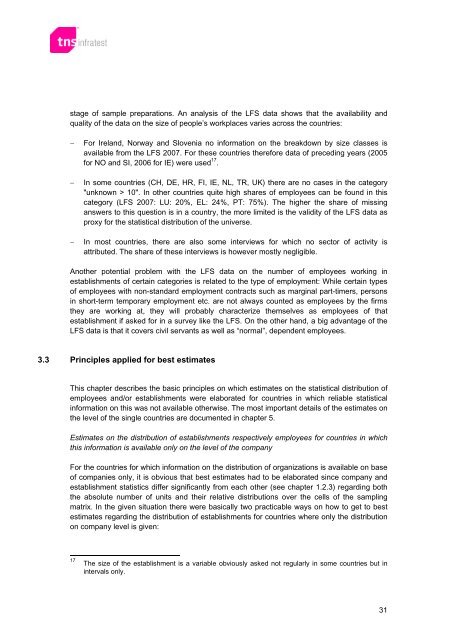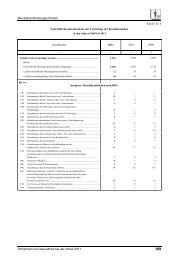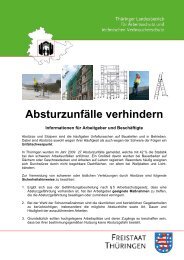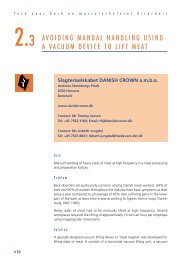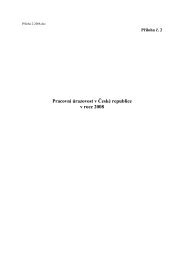ESENER-PSR 2009 - European Agency for Safety and Health at Work
ESENER-PSR 2009 - European Agency for Safety and Health at Work
ESENER-PSR 2009 - European Agency for Safety and Health at Work
Create successful ePaper yourself
Turn your PDF publications into a flip-book with our unique Google optimized e-Paper software.
stage of sample prepar<strong>at</strong>ions. An analysis of the LFS d<strong>at</strong>a shows th<strong>at</strong> the availability <strong>and</strong><br />
quality of the d<strong>at</strong>a on the size of people’s workplaces varies across the countries:<br />
For Irel<strong>and</strong>, Norway <strong>and</strong> Slovenia no in<strong>for</strong>m<strong>at</strong>ion on the breakdown by size classes is<br />
available from the LFS 2007. For these countries there<strong>for</strong>e d<strong>at</strong>a of preceding years (2005<br />
<strong>for</strong> NO <strong>and</strong> SI, 2006 <strong>for</strong> IE) were used 17 .<br />
In some countries (CH, DE, HR, FI, IE, NL, TR, UK) there are no cases in the c<strong>at</strong>egory<br />
"unknown > 10". In other countries quite high shares of employees can be found in this<br />
c<strong>at</strong>egory (LFS 2007: LU: 20%, EL: 24%, PT: 75%). The higher the share of missing<br />
answers to this question is in a country, the more limited is the validity of the LFS d<strong>at</strong>a as<br />
proxy <strong>for</strong> the st<strong>at</strong>istical distribution of the universe.<br />
In most countries, there are also some interviews <strong>for</strong> which no sector of activity is<br />
<strong>at</strong>tributed. The share of these interviews is however mostly negligible.<br />
Another potential problem with the LFS d<strong>at</strong>a on the number of employees working in<br />
establishments of certain c<strong>at</strong>egories is rel<strong>at</strong>ed to the type of employment: While certain types<br />
of employees with non-st<strong>and</strong>ard employment contracts such as marginal part-timers, persons<br />
in short-term temporary employment etc. are not always counted as employees by the firms<br />
they are working <strong>at</strong>, they will probably characterize themselves as employees of th<strong>at</strong><br />
establishment if asked <strong>for</strong> in a survey like the LFS. On the other h<strong>and</strong>, a big advantage of the<br />
LFS d<strong>at</strong>a is th<strong>at</strong> it covers civil servants as well as “normal”, dependent employees.<br />
3.3 Principles applied <strong>for</strong> best estim<strong>at</strong>es<br />
This chapter describes the basic principles on which estim<strong>at</strong>es on the st<strong>at</strong>istical distribution of<br />
employees <strong>and</strong>/or establishments were elabor<strong>at</strong>ed <strong>for</strong> countries in which reliable st<strong>at</strong>istical<br />
in<strong>for</strong>m<strong>at</strong>ion on this was not available otherwise. The most important details of the estim<strong>at</strong>es on<br />
the level of the single countries are documented in chapter 5.<br />
Estim<strong>at</strong>es on the distribution of establishments respectively employees <strong>for</strong> countries in which<br />
this in<strong>for</strong>m<strong>at</strong>ion is available only on the level of the company<br />
For the countries <strong>for</strong> which in<strong>for</strong>m<strong>at</strong>ion on the distribution of organiz<strong>at</strong>ions is available on base<br />
of companies only, it is obvious th<strong>at</strong> best estim<strong>at</strong>es had to be elabor<strong>at</strong>ed since company <strong>and</strong><br />
establishment st<strong>at</strong>istics differ significantly from each other (see chapter 1.2.3) regarding both<br />
the absolute number of units <strong>and</strong> their rel<strong>at</strong>ive distributions over the cells of the sampling<br />
m<strong>at</strong>rix. In the given situ<strong>at</strong>ion there were basically two practicable ways on how to get to best<br />
estim<strong>at</strong>es regarding the distribution of establishments <strong>for</strong> countries where only the distribution<br />
on company level is given:<br />
17<br />
The size of the establishment is a variable obviously asked not regularly in some countries but in<br />
intervals only.<br />
31


